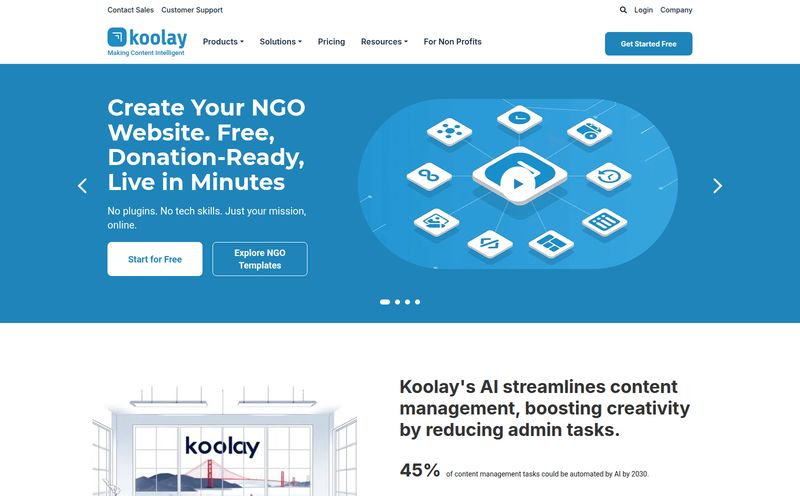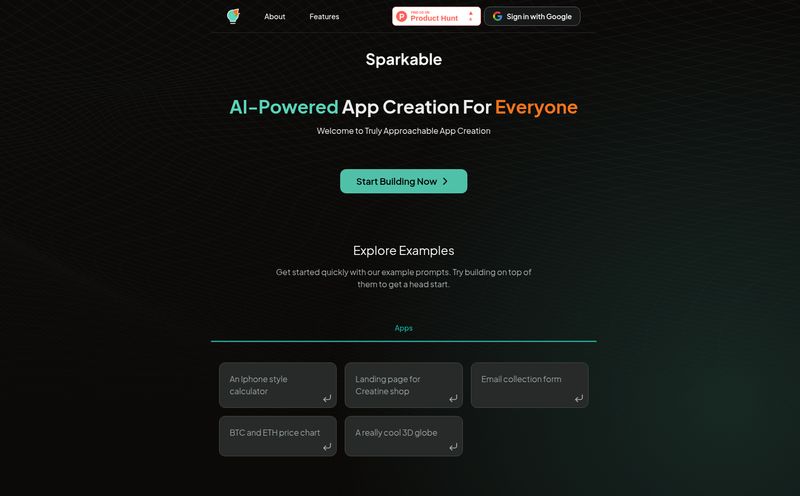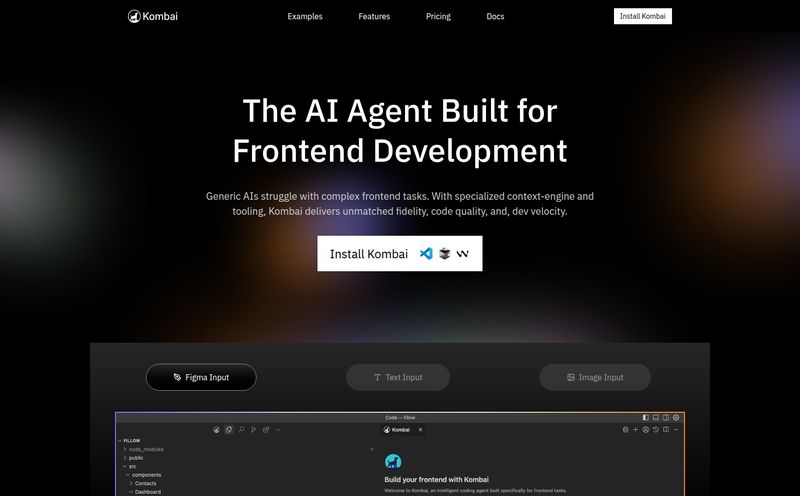Alright, let’s have a chat. Every other day, my inbox gets flooded with some new AI tool that promises to “revolutionize” my workflow. Most of them are, frankly, variations on a theme we’ve all seen before. A slightly better content generator, a slicker image creator… you know the drill. It’s getting a bit noisy out there.
But then, every once in a while, something pops up on the radar that makes you lean in a little closer. For me, this week, that thing is PointDrift. The tagline on their stark, minimalist website is a bold one: “Changing how we think about code through AI computing.”
That’s a big claim. We’re not just talking about autocompleting a line of code here. We’re talking about changing the fundamental way we conceptualize and create software. And honestly, I'm intrigued. Skeptical, for sure, but definitely intrigued. So, I did what any self-respecting tech nerd would do: I clicked around, hit a few dead ends, and joined their waitlist. Now, let’s talk about what this thing is supposed to be.
What Exactly Is PointDrift?
Peeling back the marketing layer, PointDrift presents itself as a new breed of AI coding assistant. It's not just a souped-up version of IntelliSense or a simple code completion tool. The core idea seems to be to bridge the gap between human ideation and machine execution. Think about it. How many projects start on a whiteboard, a napkin, or in a mind-mapping tool? That initial spark of genius, the flow of logic… that’s where the real creation happens. PointDrift claims it wants to live in that space.
It’s built on three pretty fascinating pillars.
From a Mindmap to Actual Machine Code
This is the one that really grabbed me. The ability to convert a mindmap directly into functional code. I mean, c'mon. This is the holy grail for so many developers and project managers. It’s like having a hyper-intelligent interpreter who can look at your brainstorming session—your web of ideas, functions, and user flows—and just… build it. You’re not just describing the ‘what’; you’re mapping out the ‘how’ visually, and the AI handles teh translation. If this works as advertised, it could dramatically shorten development cycles. It’s a bit like an architect handing over a blueprint and a machine just 3D-prints the entire building, plumbing and all.

Visit PointDrift
Your Personal AI Debugging Partner
We’ve all been there. It’s 2 AM. You’re staring at a bug that makes absolutely no sense. You’ve been through the same block of code a hundred times, and your brain has officially turned to mush. PointDrift suggests it can be that fresh pair of eyes. An AI assistant that doesn’t get tired, frustrated, or need coffee. By analyzing your code, it aims to pinpoint errors, suggest fixes, and explain the logic behind the problem. This isn’t just about finding a missing semicolon; it's about untangling complex logical knots that can stall a project for days.
A Translator for Entire Codebases
Anyone who’s ever had to work on a legacy system just felt a little shiver down their spine. The sheer terror of being asked to migrate a massive, ancient codebase from, say, COBOL to Python is the stuff of nightmares. PointDrift’s codebase translation feature is a massive promise. The idea of feeding an entire repository of old code into an AI and getting a modernized, functional equivalent on the other side is… well, it's a game-changer. I once spent the better part of six months on a PHP 5.x to Node.js migration. It was painful. A tool that could have automated even 70% of that work would have been worth its weight in gold.
The Big Question Mark: A Waitlist and a Whole Lot of Mystery
So, here’s the catch. For all its grand promises, PointDrift is currently playing its cards very close to its chest. The website is sleek but sparse. The main call to action is to “Join our Waitlist.” And if you try to get clever and find the pricing page? You're greeted with a quirky, if unhelpful, 404 page that says, “Hey! Nothing here!”
This ‘stealth mode’ approach is a bold strategy. On one hand, it builds hype and a sense of exclusivity. On the other, it fuels skepticism. Without demos, documentation, or user testimonials, we’re left to take their word for it. It makes you wonder, is the tech not quite ready for primetime, or are they just masters of marketing suspense?
How Does It Fit in the Crowded AI Coding World?
The AI assistant space isn't empty. We have giants like GitHub Copilot, which has already become an indispensable part of many developers' toolkits. Copilot is fantastic at in-line suggestions and generating boilerplate code. It's like an incredibly knowledgeable pair programmer whispering in your ear.
PointDrift, however, seems to be aiming for a different, higher-level role. Where Copilot helps you write the code line-by-line, PointDrift wants to help you architect the code from a conceptual level. It's the difference between a master bricklayer and the architect who designed the cathedral. They are both incredibly valuable, but they operate at different stages of the process. If PointDrift can nail the 'mindmap-to-code' feature, it’s not really a Copilot competitor; it's a new category of tool altogether.
The Good, The Bad, and The AI-Powered
Since we can’t test it yet, let's break down the potential based on what we know. It's a classic case of weighing immense potential against some very real-world concerns.
The Potential Upsides are Huge
The biggest pro is the sheer streamlining of the development workflow. Reducing the friction between an idea and a first draft of a working application is massive. It frees up senior developers to focus on high-level architecture and complex problem-solving instead of getting bogged down in repetitive coding. For junior devs, the debugging assistant could be an incredible learning tool, not just fixing code but explaining why it was broken. And that codebase translator? It could save companies millions in modernization costs. It's all very exciting.
The Potential Downsides and Hurdles
Let's be real, though. The effectiveness of a tool like this lives and dies by the quality of its AI. If the mindmap-to-code feature generates buggy, inefficient, or unmaintainable spaghetti code, it's worse than useless. It creates more work. There’s a risk of developers becoming over-reliant on the AI, potentially losing a deeper understanding of the code they’re shipping. And of course, the biggest con right now is that it's vaporware to the public. It’s an idea on a landing page. An exciting idea, but an idea nonetheless.
And the Price Tag Is…
… a complete mystery. The 404 on the pricing page tells us everything and nothing. I would speculate that we'll see a tiered subscription model, similar to other developer SaaS tools. Maybe a free tier for small projects, a pro tier for individual developers, and an enterprise plan for teams, likely priced based on seats or usage. But until they pull back the curtain, your guess is as good as mine.
So, What's the Final Verdict on PointDrift?
I find myself in a state of what I'll call 'educated optimism.' My years in this industry have taught me to be wary of hype. But the problems PointDrift is trying to solve are so fundamental and so… annoying… that I can’t help but root for them.
Transforming high-level human creativity directly into code is the next logical step in software development. We went from punch cards to assembly, from assembly to C, from C to Python and JavaScript. The next leap is from language to pure logic. PointDrift might not be the one to perfect it, but it’s pointing in a fascinating direction.
For now, I'm on the waitlist. I’ll be watching my inbox, and you can bet I’ll be back with a hands-on review the second I get access. What do you think? Is this the future, or just another shiny object?
Frequently Asked Questions about PointDrift
- 1. What is PointDrift in simple terms?
- PointDrift is an AI-powered tool for software developers that aims to do three main things: turn visual mindmaps into working code, help debug existing code by finding and explaining errors, and translate entire projects from one programming language to another.
- 2. How is PointDrift different from GitHub Copilot?
- While both are AI coding tools, they focus on different tasks. GitHub Copilot primarily works inside your code editor to suggest lines of code as you type. PointDrift aims to work at a higher level, generating entire code structures from a conceptual mindmap before you even start typing.
- 3. Can I use PointDrift right now?
- No, not currently. As of now, PointDrift is in a pre-launch phase. The only way to get potential access is by signing up for the waitlist on their official website.
- 4. Is PointDrift a free tool?
- The pricing for PointDrift has not been announced. Their pricing page is not yet public, so it is unknown if there will be a free tier or what the subscription costs might be.
- 5. What are the main advertised features of PointDrift?
- The three core features highlighted are Mindmap-to-code conversion, advanced AI-assisted debugging, and full codebase translation between different programming languages.
- 6. Is there a risk in using AI to write code?
- Yes, there are always risks. The quality and security of AI-generated code must be carefully reviewed by a human developer. Over-reliance on such tools could also potentially weaken a developer's core coding skills if not used as a supplementary tool for learning and efficiency.
Reference and Sources
- PointDrift Official Website: While sparse, the primary source of information.
- GitHub Copilot: For comparison of features and market positioning.



